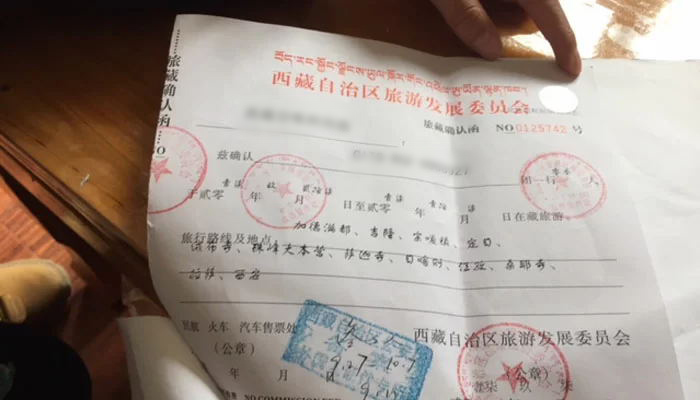The Xinjiang-Tibet Highway is the most challenging route among all highways to Tibet, connecting Kashgar in Xinjiang with Lhasa in Tibet. Spanning around 2,942 kilometers, the route takes you through a variety of breathtaking landscapes, including the sacred Mount Kailash and Lake Manasarovar.
In this guide, we’ll walk you through all the essential details about the Xinjiang-Tibet Highway. Read on to discover the full travel route, top attractions along the way, how many days the journey takes, the best time to go, what permits you’ll need, and more. Get ready for a smooth and epic overland journey to Tibet!
Xinjiang Tibet Highway Overview: Where is It and How High is It?
The Xinjiang-Tibet Highway, officially known as China National Highway G219, is one of the highest roads in the world. It begins in the county of Yecheng, in Kashgar Prefecture of the Xinjiang Uygur Autonomous Region, and stretches southward to Lhatse in Tibet, where it connects with the main Friendship Highway and continues eastward to Lhasa.
Covering a total distance of 2,942 kilometers from Yecheng to Lhasa, the Xinjiang-Tibet Highway has an average altitude of more than 4,500 meters. It passes through the Karakoram Mountains and crosses five mountain passes over 5,000 meters, with the highest reaching 5,433 meters.
This highway is the most challenging route among all roads to Tibet, but most of it is well-paved. Only certain sections within Xinjiang, such as the stretch from Yecheng to the 30-Mile Barracks, are quite rugged. However, once you enter Tibet, the road conditions improve significantly, especially where it merges with the G318 Highway to Lhasa.
 Xinjiang-Tibet Highway passes through the Jieshan Pass at an altitude of 5,347 meters.
Xinjiang-Tibet Highway passes through the Jieshan Pass at an altitude of 5,347 meters.Join our most popular Kailash Manasarovar tour for a smooth experience!
Xinjiang Tibet Highway Route: How to Travel from Kashgar to Lhasa via Mount Kailash?
Starting from Kashgar, the classic overland journey along the Xinjiang-Tibet Highway can be divided into two main sections: the first section from Kashgar to Shiquanhe, and the second from Shiquanhe to Lhasa via Mount Kailash and Mount Everest.
The First Section: Kashgar to Shiquanhe (The Tough Section)
This section covers about 1,305 kilometers and consists mostly of tarred and unpaved roads through remote and wild uninhabited areas. Starting in Kashgar, you’ll travel southeast, passing through Yecheng, the 30-Mile Barracks (Sanshili Yingfang), and Rutog, before finally reaching the small town of Shiquanhe in Ngari Prefecture, Tibet.
Along the way, you’ll climb through the Kunlun and Karakoram mountain ranges, with altitudes reaching over 5,170 meters. You’ll also be treated to stunning views of Pangong Lake along the roadside before arriving in Rutog.
 The Xinjiang-Tibet Highway passes by Pangong Lake.
The Xinjiang-Tibet Highway passes by Pangong Lake.The Second Section: Shiquanhe to Lhasa via Mt Kailash and Mt Everest (The Scenic Section)
The second section spans about 1649 kilometers, with most roads in good condition and well-paved. From Shiquanhe, the journey continues to Darchen, a small town located at the foot of Mount Kailash. Here, you can take the sacred 3-day Kailash kora trek before heading onward.
Leaving Darchen, you will travel eastwards to Everest Base Camp via Saga. Situated at an elevation of 5,000 meters, Everest Base Camp is accessible by car and offers a magnificent close-up view of the towering summit of Mount Everest. You can also stay overnight at the camp to witness the brilliant sunset, sunrise, or even starry sky.
From there, the journey continues to Shigatse via Lhatse, then on to Gyantse and turquoise Yamdrok Lake, before finally arriving in Lhasa. This final leg follows the return route of the popular 8-day Lhasa to Everest Base Camp tour, covering both the natural wonders and rich cultural heritage of Tibet.
 You can visit Tibet Everest Base Camp by taking the Xinjiang Tibet Highway trip.
You can visit Tibet Everest Base Camp by taking the Xinjiang Tibet Highway trip. Xinjiang Tibet Highway Attractions: What to See along the Way?
The route of Xingjiang Tibet Highway is packed with breathtaking sights and cultural landmarks. Here are some major attractions you are expect to see along the way:
1. Kashgar Old City
With narrow alleyways, traditional Uyghur architecture, and bustling bazaars, Kashgar Old City offers a glimpse into Central Asian life and Silk Road heritage. Here you can visit the Id Kah Mosque or a walk through the Sunday livestock market.
 Kashgar Old City offers a glimpse into Central Asian life and Silk Road heritage.
Kashgar Old City offers a glimpse into Central Asian life and Silk Road heritage.2. Pangong Lake
Before arriving in Rutog, you'll pass the Pangong Lake. Its deep blue waters and surrounding snow-capped mountains make it one of the most photogenic spots on the route.
3. The Ruins of the Guge Kingdom
The Guge Kingdom, founded in the 10th century, comes to life through its old temples, grand palaces, and colorful wall paintings, giving you a glimpse into its once-mysterious culture.
 Guge Kingdom is an amazing site in western Tibet.
Guge Kingdom is an amazing site in western Tibet.4. Mount Kailash
Undoubtedly one of the most sacred mountains in Asia, Mount Kailash is revered by Buddhists, Hindus, Jains, and followers of the Bon religion. For many, the 3-day kora trek around the mountain is the highlight of the entire journey.
5. Lake Manasarovar
Lake Manasarovar sits just south of Mount Kailash and is one of the highest freshwater lakes in the world. Its clear, calm waters reflect the nearby mountains like a mirror and are considered sacred. Many pilgrims come here to bathe, hoping to cleanse both body and soul.
 Lake Manasarovar is one of the three holiest lakes in Tibet.
Lake Manasarovar is one of the three holiest lakes in Tibet.6. Everest Base Camp (North Side)
One of the most exciting stops on this trip is the north side of Everest Base Camp. From here, you get a clear and amazing view of the north face of Mount Everest. Watching the sunrise or sunset light up the world’s tallest mountain is an experience you’ll never forget.
7. Tashilhunpo Monastery in Shigatse
Founded by the first Dalai Lama, it’s one of the most important monasteries in Tibet and still serves as the seat of the Panchen Lama.
 Tshilhunpo Monastery serves as the seat of the Panchen Lama.
Tshilhunpo Monastery serves as the seat of the Panchen Lama.8. Yamdrok Lake
As one of the three holy lakes in Tibet, Yamdrok Lake is surrounded by snow-capped mountains. It stretches like a beautiful blue ribbon winding through the hills, making it a perfect spot for photography.
Xinjiang Tibet Overland Tour Duration: How Many Days Are Needed?
Traveling overland from Kashgar to Lhasa along the Xinjiang-Tibet Highway typically takes around 10 days, depending on your pace. If you plan to add the three-day Mount Kailash trek and a stop at Everest Base Camp, the trip can stretch to about 14 days. For those who also want to explore the highlights of Kashgar and Lhasa, a full journey of around 18 days is recommended.
Due to the high altitude and long driving distances, it’s important not to rush. Taking time to rest and explore will not only help you acclimate to the altitude but also make the journey much more enjoyable.
Join our most popular Kailash Manasarovar tour for a smooth experience!
Xinjiang Tibet Highway Weather: When Is the Best Time to Travel?
The best time to take a Xinjiang Tibet overland tour via Xinjiang-Tibet Highway is from May to October. During this period, the weather is relatively mild and stable, and the snow has melted on most high mountain passes. Road conditions are also generally better during these months.
July and August are the warmer months, featuring vibrant landscapes and lush scenery, making them the peak travel season. While there may be occasional rain, it usually falls at night and rarely disrupts daytime travel. However, be aware of potential natural hazards such as landslides and mudslides during this time.
Winter travel during November to the following April is not recommended, as many sections of the highway may be closed due to heavy snow and extreme weather. It could be dangerous to drive on icy roads.
 The best time to take Xinjiang Tibet highway overland tour is from May to October.
The best time to take Xinjiang Tibet highway overland tour is from May to October.Xinjiang Tibet Travel Documents: What Permits Do I Need?
Traveling from Xinjiang to Tibet requires several permits. First, you need to obtain a Chinese Visa to visit both Xinjiang and Tibet. However, if you are from a visa-free country for China, you don’t need to get the visa in advance.
Before entering the Tibet Autonomous Region, you must also obtain a Tibet Travel Permit and join an organized tour arranged by a registered Tibetan travel agency. In addition, for traveling through the Ngari region of Tibet, you will need both the Aliens’ Travel Permit and the Military Permit.
As the leading Tibet tour operator based in Lhasa, we can help you apply for all of these documents. Once you book your Tibet tour with us, simply send us copies of your Chinese Visa and passport, and then we’ll take care of the rest. We recommend contacting us at least 20 days in advance to avoid any delays.
 Tibet Travel Permit is a must for touring Tibet.
Tibet Travel Permit is a must for touring Tibet.Insider Tips: How to Enjoy a Safe and Smooth Xinjiang-Tibet Highway Trip?
Traveling along the Xinjiang-Tibet Highway is an incredible experience, but it also requires preparation. Here are some insider tips to ensure a safe and rewarding journey:
1. Acclimatize gradually: The route crosses many high mountain passes, so it's important to take it slow to avoid altitude sickness. Spend a few days in Kashgar or other lower-altitude areas before ascending.
2. Pack wisely: Bring warm clothing for the cold nights. Sun protection is also essential - pack a hat, sunglasses, and sunscreen, as the sunshine on the Tibetan Plateau is very strong. Don’t forget basic medicines, snacks, and plenty of drinking water.
3. Stay connected: Internet and mobile service can be limited or blocked in remote areas. Download maps and essential apps beforehand, and let someone know your itinerary.
4. Respect local culture: The route passes through regions inhabited by both Uyghur Muslims and Tibetan Buddhists. Dress modestly, ask for permission before taking photos, and be mindful of local customs and traditions.
Join our most popular Kailash Manasarovar tour for a smooth experience!
Conclusion
The Xinjiang-Tibet Highway is the highest road in the world, and the most challenging route to enter Tibet. However, it rewards travelers with breathtaking landscapes and iconic attractions along the way, including Pangong Lake, Mount Kailash and Lake Manasarovar, Mount Everest, Yamdrok Lake, and more. The overland journey typically takes between 10 to 18 days, depending on your itinerary.
With proper preparation and the right travel documents, this journey can become a once-in-a-lifetime adventure. As the leading Tibet tour operator with years of experience, we’re here to ensure a smooth and unforgettable trip. Feel free to contact us or book your tour with us today!


























 Xinjiang-Tibet Highway passes through the Jieshan Pass at an altitude of 5,347 meters.
Xinjiang-Tibet Highway passes through the Jieshan Pass at an altitude of 5,347 meters.
 The Xinjiang-Tibet Highway passes by Pangong Lake.
The Xinjiang-Tibet Highway passes by Pangong Lake. You can visit Tibet Everest Base Camp by taking the Xinjiang Tibet Highway trip.
You can visit Tibet Everest Base Camp by taking the Xinjiang Tibet Highway trip.  Kashgar Old City offers a glimpse into Central Asian life and Silk Road heritage.
Kashgar Old City offers a glimpse into Central Asian life and Silk Road heritage. Guge Kingdom is an amazing site in western Tibet.
Guge Kingdom is an amazing site in western Tibet. Lake Manasarovar is one of the three holiest lakes in Tibet.
Lake Manasarovar is one of the three holiest lakes in Tibet. Tshilhunpo Monastery serves as the seat of the Panchen Lama.
Tshilhunpo Monastery serves as the seat of the Panchen Lama. The best time to take Xinjiang Tibet highway overland tour is from May to October.
The best time to take Xinjiang Tibet highway overland tour is from May to October. Tibet Travel Permit is a must for touring Tibet.
Tibet Travel Permit is a must for touring Tibet.






Ask a Quick Question